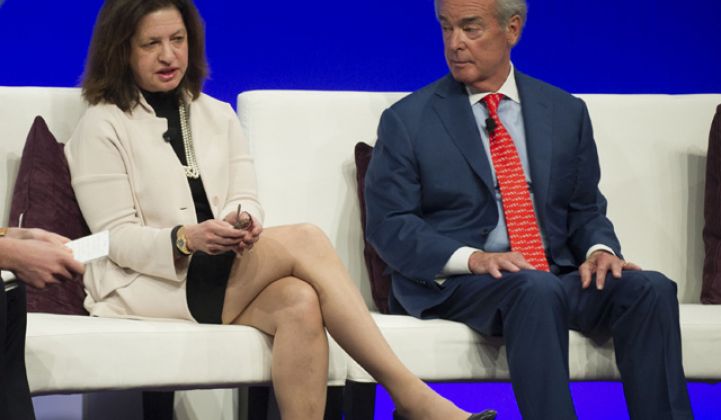In his former role as CEO of Duke Energy, Jim Rogers was largely seen as a forward-thinking leader, encouraging his industry to support U.S. climate legislation nearly a decade ago, and later supporting rooftop solar.
At the Bloomberg New Energy Finance event in New York City this week, his stance was decidedly less cutting-edge. “We have these visionary solutions looking for problems,” Rogers said about technology changes happening in the utility industry. “How can we improve upon 99.9 percent reliability? Do we need to?”
He questioned the value of deregulated markets to foster innovation. Rogers, who noted that he was asked to be provocative, said that North Carolina was aggressively installing rooftop solar even though it is a state with vertically integrated utilities.
“I see most of the modernization going on in the vertically integrated, regulated markets,” said Rogers. “I never thought of myself as defending the status quo, but it feels pretty good.”
Audrey Zibelman, chair of the New York Public Services Commission, was unimpressed by Rogers’ pitch for the status quo. She noted that prices have fallen in deregulated New York because of its electricity markets, and inefficient merchant generation has been retired. “You can’t argue with efficiency,” she said, adding that the efficiency of generators in wholesale markets has increased overall.
“And, with all due respect, North Carolina participates in MISO and PJM,” she added, referring to two regional wholesale markets. “So it’s the best of both worlds without having competition in your own back yard.”
In some ways, Zibelman and Rogers were having the exact same conversation, but predicting very different ways in which it would play out. “I think the ultimate goal should be optimization of the use of the system,” said Rogers.
Zibelman made it clear that that is exactly what New York is trying to achieve with its Reforming the Energy Vision proceeding, which will value efficiency and manage demand dynamically to both eliminate peaks and optimize the system.
“We need to incent utilities differently,” Zibelman said of the transformation, essentially echoing Rogers' call for change to utility incentives. In New York, it is a complete overhaul in the way distribution utilities will do business. In some ways, it's only possible to have such a transformation in the coming years because the state is already deregulated. “We’re making the utility the enabler of change instead of a deer in the headlights that says, ‘I don’t know where we’re going to go, but it’s not going to be here.’”
Even as Zibelman outlined New York’s vision of a market that uses predictive pricing to manage elasticity in demand, Rogers said that finding a regulatory model that compensates utilities to optimize their system would be very difficult.
The issue seemed to be that Rogers was suggesting a vision of utility reform that would not necessarily scrap the rate-base model that has been around as long as the utilities. But in New York, the distribution utilities won’t even be utilities in the traditional sense anymore -- they’ll be distribution service platform providers.
New York has the advantage of being one of only a few states that has an independent system operator just for that state, rather than the surrounding region. That makes it easier for New York to implement the sort of changes it is striving for, whereas similar transformations at the electric distribution level will look different in other regions.
But Zibelman and others in New York see REV as not only benefiting New York, but also as a model and a technology enabler that will be exported far beyond the state's borders.
“I think that Jim and I will have this conversation for a while,” said Zibelman, “Then someone will write a book and say, ‘She was right and he was wrong.’”



